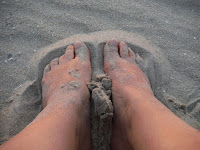This blog post first appeared on Curtis Buffer News blog Dec 2020
Thanks to all of you who have stopped by to offer encouragement and help over the past year as we continue our invasive remediation work along Rock Creek. I feel like we could use one of those “Under Construction” signs as we clear new areas of vines and other plants damaging or killing trees.
 |
| Ballroom covered in knotweed and vines |
 |
| Ballroom after cutting vines and knotweed |
We now have a crew of 8 volunteers! We’ve made more progress than we ever thought possible in one year, especially with a pandemic raging. We started the year at the upper reaches of the creek in the arboretum where a combined sewer overflow directs street runoff into Rock Creek. We’ve installed erosion markers which we are monitoring to see the effects of storm damage. Each month we assess the water quality and flow so we can get a fuller picture of the health of the stream over time. We also did our first detailed annual wildlife habitat survey. A healthy stream isn’t just important for the animals that rely on it, but it’s important for our human health as well. The water from Rock Creek is part of the watershed that supplies our area with drinking water! Water that runs off our streets eventually ends up in our showers or water glasses, after treatment of course. The cleaner the water is before treatment the better for us and the planet.
 |
| Fungus growing on a dead tree |
Trees are an important part of creating a healthy stream ecosystem. They provide cooling shade necessary for fish, frogs and insects. Tree roots also keep soil from washing away. Erosion harms animals that live in the water. Curtis Arboretum has lost many trees along Rock Creek from vine damage. This year we’ve freed 100+ canopy trees and 200+ understory trees and bushes from strangling vines. Our work has included both sides of Rock Creek and we’ve planted a total of 29 native trees to replace some of the trees we’ve lost. We’ve also seen native flowers reappear from seeds lying dormant in the earth waiting for the opportunity to grow.
 |
| Native flowers |
While working, we’ve seen deer, skunk, herons, woodpeckers, migratory warblers and scarlet tanagers, hawks, vultures, as well as other more common birds like robins, wrens and catbirds. The stream is home to minnows, water striders, and frogs. We’ve even spotted iridescent jewelwing damselfly! Even with all this abundance of species, Rock Creek still needs our help to allow more sensitive species to thrive. This year, to see if salt is affecting stream biodiversity, we’ve begun a salt monitoring program. We made a baseline measurement and we’ll do measurements after salt application on streets occurs later this year.
 |
| Young oak planted in the cleared Ballroom |
It’s been an exciting year and we’ve uncovered gorgeous hidden spaces and even given them names like: the Ballroom, Spice Bush Grove, Skunk Hallow and Jenga Dam. Take some time and explore Rock Creek, walk softly and you may see some of the creatures that inhabit this urban wilderness.


Comments
Post a Comment